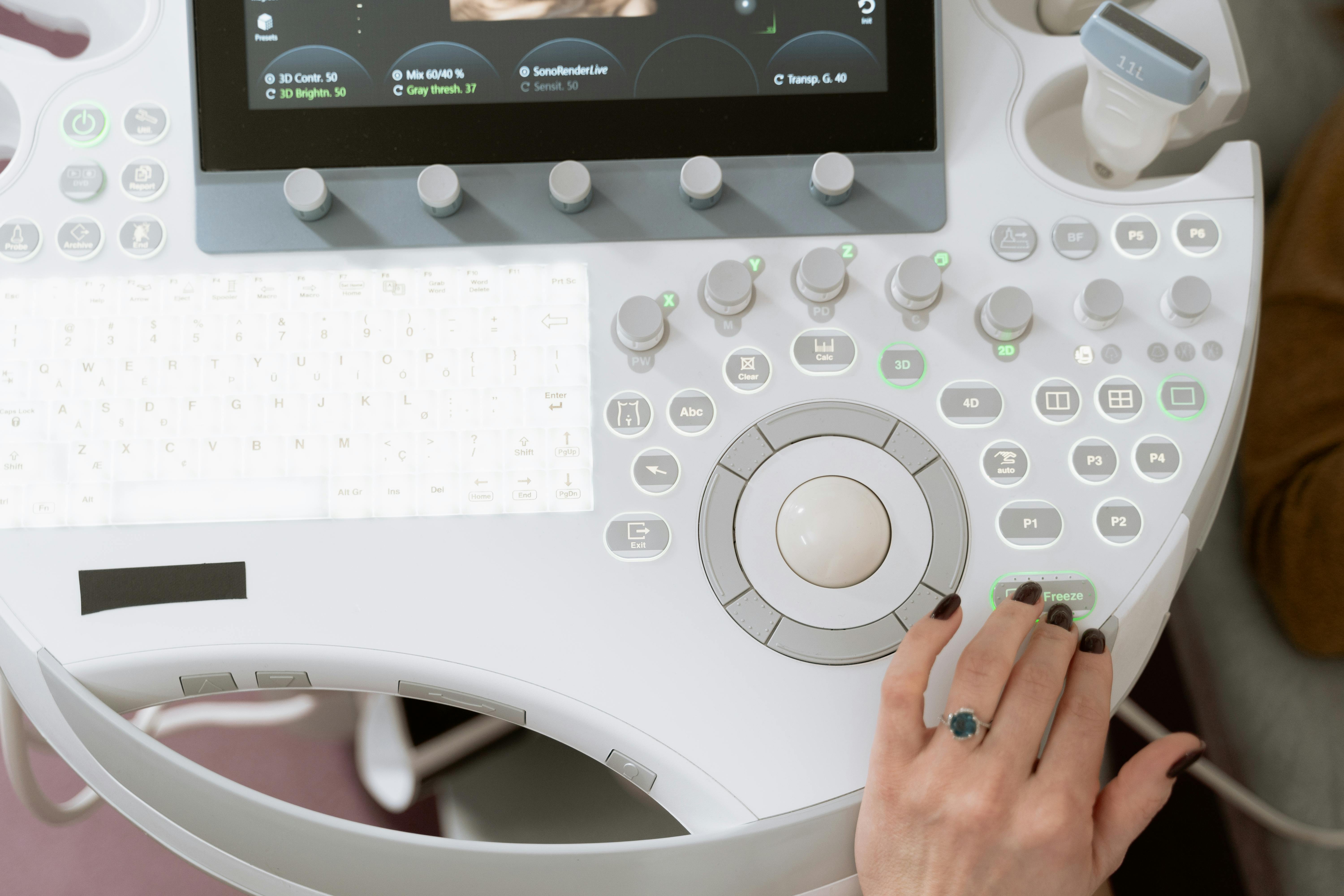Liver Ultrasound: All You Need to Know
What is a liver ultrasound scan?
A liver ultrasound (also called hepatic sonography) is a non-invasive, painless imaging test that uses high frequency sound waves to produce detailed images of the liver, its blood vessels and surrounding structures.
During a liver ultrasound scan, you’ll lie flat on your back on an elevated bed. A sonographer (ultrasound technician) will move a small hand-held device (called a transducer or ultrasound probe) over the upper right side of your abdomen, near your ribs. To get adequate visibility of your liver, they will ask you to exhale, take a deep breath, and hold for a while or roll onto your left side and place your right arm over your head.
The transducer emits high-frequency sound waves that penetrate your skin and bounce or echo back with varying speeds and intensities as they encounter different tissue types. These echoes are then picked up by the transducer and converted into real-time images of your liver on a nearby computer.
Why would a doctor order a liver ultrasound?
If a doctor wants ultrasound of liver, it can be for any of these reasons:
-
You are experiencing symptoms of liver disease, such as jaundice (yellowing of the skin and whites of the eyes), persistent abdominal pain, dark urine, light-coloured stool, nausea, or itchy skin.
-
A blood test called liver function test (LFT) shows that you have elevated levels of liver enzymes.
-
You have several risk factors for liver disease, including ongoing moderate or heavy alcohol consumption, obesity, type-2 diabetes, and a family history of liver disease.
-
You have already been diagnosed with a liver disease, and it is necessary to check how your liver is responding to treatment.
Ultrasound is a highly recommended, accurate, and reliable imaging tool for diagnosing and monitoring liver problems. But other tests, like a CT and MRI scan, offer comparable—or even higher—detection rates and better detailed images. If you need help deciding whether the ultrasound is the right choice for your unique liver health concerns, consider booking a consultation for just £50. You'll match with an expert clinician who will call to discuss your medical history, provide education on the best available options, and offer a no-obligation referral. If you do decide to book a scan, we’ll discount your fee by £50.
What does a liver ultrasound scan show?
A liver ultrasound provides detailed images of the liver, allowing healthcare professionals to assess changes in its size, shape, and texture. A special type of ultrasound called elastography ultrasound (or transient elastography) measures a liver’s stiffness and detects fibrosis, a reversible scarring of liver tissues. Similarly, Doppler ultrasound may be used to evaluate blood flow in the liver’s vascular network, including the hepatic artery and portal vein.
A liver ultrasound scan can be used to detect and monitor the different progressive stages of chronic liver disease, including:
-
Hepatitis (inflammation of the liver).
-
Steatosis (fat build-up in the liver), including alcohol-related fatty liver disease and non-alcoholic fatty liver disease.
-
Cirrhosis (permanent scarring of the liver).
It can also show abnormalities, including:
-
Focal Liver Lesions (Abnormal Growths):
-
Cysts (fluid-filled mass).
-
Hemangioma (abnormal blood vessels clustered together).
-
Hepatocellular carcinoma (commonly occurring type of primary liver cancer).
-
Vascular Conditions:
-
Portal Hypertension
-
Portal Vein Thrombosis (narrowing or blockage of the portal vein by a blood clot).
-
Ischemia (reduced blood flow to the liver).
-
Biliary Diseases:
-
Gallstones.
-
Cholecystitis (inflammation of the bladder wall).
-
Cholangiocarcinoma (bile duct cancer).
In most cases, additional imaging tests or a biopsy may be needed for a more comprehensive evaluation and confirmative diagnosis.
Let’s quickly go over what a normal liver ultrasound and an abnormal result can show.
Normal liver ultrasound
A normal liver ultrasound typically shows a liver with smooth edges, normal-sized lobes, homogeneous texture, and consistent echogenicity (i.e., the liver tissues reflect sound waves at the same speed and intensity). There are no signs of inflammation, masses or abnormalities. Blood vessels and bile ducts also appear normal, without any blockages. It may also show the gallbladder free of stones.
Abnormal liver ultrasound
An abnormal liver ultrasound can be any of the following:
-
Fatty liver ultrasound
What does fatty liver look like on ultrasound? - Fatty liver disease often appears as a bright liver on ultrasound. Due to excess fat deposits in its tissues, a fatty liver will reflect more sound waves faster and more intensely than normal liver tissues and surrounding structures, meaning that it is hyperechoic. Your ultrasound result might report it as “increased parenchymal echogenicity.”
While fatty liver disease appears bright or white on an ultrasound, inflamed liver (hepatitis) may appear darker (i.e., hypoechoic), compared to surrounding tissues.
-
Liver cancer ultrasound
Liver cancer can be easily seen on an ultrasound because it stands out from surrounding tissue. Although, large masses are more easily detectable than smaller ones. It may appear as a darker (hypoechoic) or brighter (hyperechoic) spot.
-
Cirrhosis liver ultrasound
A cirrhosis liver ultrasound usually shows a liver that is shrunken and bumpy with irregular edges. Due to the presence of lesions or nodules, some parts of the liver may echo sound waves more intensely than others, resulting in inconsistent echogenicity (i.e., bright and dark coloured areas). If a Doppler ultrasound is used, it may show an enlarged portal vein and impaired blood flow in and out of the liver.
-
Normal liver vs cirrhosis ultrasound
There are some key differences between normal vs cirrhosis ultrasounds. They are:
- A normal ultrasound would show:
- Smooth liver edges
- Homogenous liver texture
- Normal liver size
- Consistent echogenicity throughout the liver tissue
- Absence of nodules or masses
- Normal blood flow in the hepatic veins and portal vein
- While a cirrhosis ultrasound would show:
- Irregular liver edges
- Coarse or nodular liver texture
- Shrunken liver size
- Heterogeneous echogenicity with areas of increased brightness (hyperechoic) and decreased brightness (hypoechoic)
- Presence of nodules or regenerative nodules on the liver surface
- Disrupted blood flow patterns and possible signs of portal hypertension
How long does a liver ultrasound take?
A liver ultrasound scan can take around 15 to 30 minutes. However, it can last a little longer, depending on if a more thorough examination is necessary or if an additional type of ultrasound, such as Doppler ultrasound, is required.
Should I worry about a liver ultrasound?
A liver ultrasound is quick, painless, non-invasive, and relatively inexpensive. It is one of the safest diagnostic imaging methods as it doesn’t use ionising radiation, like X-rays or a CT scan. Also, it has no contraindications (i.e., situations where it may not be suitable). After your scan, you can resume your normal activities and diet immediately without experiencing any side effects.
Your liver ultrasound results will provide valuable information about the health of your liver, including its size, shape, texture, and the presence of any disease or abnormality. However, it's important to understand that detecting an abnormality doesn't automatically mean you have cancer or are facing a life-threatening situation. In many cases, a doctor will order additional tests to learn more about the findings in your ultrasound result before creating a treatment plan that is tailored to your specific needs.
We understand that the whole process of undergoing medical tests can be stressful and anxiety-inducing, which is why we have an expert team of clinicians to call you pre-scan to answer any questions you may have, provide reassurance, and ensure you are prepared for your procedure, as well as post-scan to discuss any adverse findings in the result before a copy is sent to your email.
Can I drink water before liver ultrasound scans?
Water intake may affect the liver's texture and blood flow within the portal and hepatic veins, making it difficult to measure its stiffness or identify indicators in its vascular network. To be safe, you should refrain from consuming liquids several hours before your test, unless instructed otherwise by your clinician.
You won’t need any special preparation for liver ultrasound, except that your doctor might ask you not to eat for 6 to 12 hours before your appointment. In addition to liver ultrasound fasting, you might also be asked not to chew gum or smoke to minimise bloating and allow for optimal imaging.
Can liver cancer be detected by ultrasound?
Yes! Liver cancer can be detected by an ultrasound.
An ultrasound is often the primary screening tool for investigating presenting symptoms of liver cancer because it can identify suspicious masses within the liver tissue. Even if you don’t show any symptoms, your doctor may recommend having a liver ultrasound scan every six (6) months as part of cancer screening efforts to detect tumours early, especially if you have an increased risk due to underlying conditions.
These underlying conditions include:
-
Cirrhosis
-
Chronic hepatitis B or C infection
-
Non-alcoholic fatty liver disease
-
Type-2 diabetes
-
Heavy alcohol consumption
Solid tumours, which can be benign (non-cancerous) or malignant (cancerous), often appear as a distinct spot on liver ultrasound, but so do cysts, abscesses, and fatty liver tissues. Hence, when a lump is first sighted, a sonographer will thoroughly examine the area to assess its shape, size, and border. Other indicators that will be checked include the characteristics of blood vessels that supply its nutrients, to determine whether it is a potentially dangerous solid mass.
However, an ultrasound alone isn’t enough to diagnose a tumour as liver cancer. Additional imaging tests such as a CT or MRI scan and a liver biopsy will be necessary for further evaluation and confirmative diagnosis.
Also, a routine liver ultrasound may not always detect cancer early, so a blood test that measures the levels of tumour biomarker alpha-fetoprotein (AFP) may be recommended to improve its sensitivity.
Ultrasound on liver: where can I book mine?
You can ask for a referral from your healthcare provider or book a private ultrasound liver scan online in a few minutes with Scan.com, the UK’s largest imaging network (with over 150+ scanning centres near you). No GP referral needed. No boring paperwork. No long waiting list.
When will I get my liver ultrasound results?
Although the liver ultrasound is a quick procedure, you won’t get your results immediately after the scan is done. Your sonographer passes your liver ultrasound images to a radiologist, who carefully examines them and compiles a detailed report. The report is delivered to your Scan.com clinician, who will discuss the details with you and recommend additional tests or create a treatment plan. This process might take up to two weeks on the NHS, but only takes 7 working days when you book with us.
.
Sources
-
(2017, November 9). Journal of Diagnostic Medical Sonography. Retrieved April 2, 2024, from https://www.ncbi.nlm.nih.gov/pmc/articles/PMC4520430/
-
The effect of water intake on ultrasound tissue characteristics and hemodynamics of adult livers. (2021, June 30). NCBI. Retrieved April 2, 2024, from https://www.ncbi.nlm.nih.gov/pmc/articles/PMC8284166/
-
Knipe, H. (2023, June 5). Liver ultrasound | Radiology Reference Article. Radiopaedia. Retrieved April 2, 2024, from https://radiopaedia.org/articles/liver-ultrasound
-
Liver cancer. (n.d.). Wikipedia. Retrieved April 2, 2024, from https://en.wikipedia.org/wiki/Liver_cancer
-
The liver: how we do it - PMC. (n.d.). NCBI. Retrieved April 2, 2024, from https://www.ncbi.nlm.nih.gov/pmc/articles/PMC5024840/
-
Liver problems - Symptoms and causes. (2024, February 13). Mayo Clinic. Retrieved April 2, 2024, from https://www.mayoclinic.org/diseases-conditions/liver-problems/symptoms-causes/syc-20374502
-
Screening for liver cancer. (n.d.). Cancer Research UK. Retrieved April 2, 2024, from https://www.cancerresearchuk.org/about-cancer/liver-cancer/getting-diagnosed/screening
-
Surveillance Imaging and Alpha Fetoprotein for Early Detection of Hepatocellular Carcinoma in Patients With Cirrhosis: A Meta-analysis. (2018, February 6). NCBI. Retrieved April 2, 2024, from https://www.ncbi.nlm.nih.gov/pmc/articles/PMC5927818/
-
Thomas, T. H. (2022, October 20). Ultrasound to Detect Liver Cancer: Procedure, Benefits, Risks. Healthline. Retrieved April 2, 2024, from https://www.healthline.com/health/cancer/liver-cancer-ultrasound#purpose
-
Ultrasonographic evaluation of patients with abnormal liver function tests in the emergency department. (n.d.). NCBI. Retrieved April 2, 2024, from https://www.ncbi.nlm.nih.gov/pmc/articles/PMC8942730/

